Hyperrhiz 6
Generative Visual Renku: Poetic Multimedia Semantics with the GRIOT System
D. Fox Harrell
Massachusetts Institute of Technology
Kenny K. N. Chow
Hong Kong Polytechnic University
Citation: Harrell, D. Fox and Kenny K. N. Chow. “Generative Visual Renku: Poetic Multimedia Semantics with the GRIOT System.” Hyperrhiz: New Media Cultures, no. 6, 2009. doi:10.20415/hyp/006.e03
Abstract: A polymorphic poem (polypoem) is a generative digital artwork that is constructed differently upon each instantiation, but can be meaningfully constrained according to aspects such as theme, metaphor, affect, and discourse structure. The Generative Visual Renku project presents a new form of concrete polymorphic poetry inspired by Japanese renku poetry, iconicity of Chinese character forms, and generative models from contemporary art. Calligraphic iconic illustrations are conjoined by the GRIOT system into a fanciful topography articulating the nuanced interplay between organic (natural or hand-created) and modular (mass-produced or consumerist) artifacts that saturate our lives. GRIOT, which is a system for composing generative and interactive narrative and poetic works, is used to semantically constrain generated output both visually and conceptually. On the one hand, this project extends the GRIOT architecture's support for composing graphics and has resulted in new theory to provide cognitive and semiotic groundings for the extension. On the other hand, as a work of art, it is self-reflexive in that the content concerns the modularity of consumption and production in many contemporary post-industrial societies, while the research agenda and theoretical framework are concerned with modularity of semantic units in digital media arts.
Since the industrial age, modularity has revolutionized our everyday lives. For the sake of efficiency and optimization, things and activities were shaped into mass-produced interchangeable units, including our furniture, our dwelling places, our commuting, our consumptions, our entertainments, and our identities. In consumerist societies, modularity always lies at the center, whereas the complements are just scattered peripheries. Life is a journey back and forth between clustered majorities and isolated minorities.
1 Introduction
Crossing a contemporary landscape we often encounter rhythmic repetition of factories, parking lots, train stations, occasional amusement parks — punctuating these environmental rhymes executed in banal architecture are rivers, mountains, forests, and ourselves. When a cartographer reduces these landscapes to iconic images, she or he may realize hallmarks of poetic texts: poignant repetition, surprising juxtapositions, and uncanny renderings of the everyday. The possibility of poetry composed of visual icons inspires the Generative Visual Renku project described here. We introduce a new and developing form in which a system and a user co-create a "text" consisting of a poetic composition of images.
Traditional renku is a type of linked poetry, consisting of a series of links between topical elements . The visual renku described in this paper uses iconic images rendered in a calligraphic style in place of traditional written haiku. Our visual renku is interactive, requiring users to select from depicted visual elements in order to co-select subsequent imagery. It is also generative in that subsequent imagery is dynamically composed using a computational framework called GRIOT that provides both formal visual and conceptual semantic constraints . The GRIOT system was designed to support semantics-based interaction and generation for multimedia works. Semantics-based interaction here means that the meanings of content elements are represented explicitly in the system and user actions produce results based upon these meanings. Initial cases, however, were primarily textual. The Generative Visual Renku project consists of new code that extends the GRIOT architecture to implement constraints for visual composition, revealing new technical challenges. Since modular graphical systems are ubiquitous in computing, ranging from avatar creation systems to CSS style sheets for web design, the Generative Visual Renku project poses a contribution to a broad research agenda as well, the development of new theory and technology for semantically-based graphics composition. This paper presents the theoretical framework for our project, examples of generative visual renku, and discussion of technical, creative, and theoretical challenges we encountered.
2 Theoretical and Artistic Framework
The Generative Visual Renku project draws upon an interdisciplinary theoretical framework including generative visual and literary arts, renku poetry in particular, iconicity of Chinese characters, and cognitive and computer science approaches to interactive and generative narrative and poetic discourse. Key aspects of this framework are discussed below.
2.1 Generative Visual and Literary Arts
Generative art or literature generally refers to a type of works that strongly emphasizes the processes giving rise to specific instances. The process is usually designed by the artist or writer in terms of a set of rules, a computer program, or a machine, and then is executed automatically . The Oulipo (Workshop for Potential Literature) group are perhaps the most prominent proponents of the concept in literature . In the case of visual art, many contemporary practitioners have created inspirational exemplary works, such as Josef Albers' Homage to the Square (1960s), Frank Stella's The Protractor Series (1967-69), Sol LeWitt's Incomplete Open Cubes (1973-4), Jennifer Bartlett's Rhapsody (1975), and Xu Bing's Book from the Sky (1988). The aesthetic sensibility of such works focuses on directing viewers to consider processes rather than individual instances of output. Meaning is typically embedded in the form as opposed to content.
Philip Galanter points out that in generative art the artist usually uses an external rule system to displace arbitrary and intuitive decisions. However, Galanter also attempts to distinguish generative art from any simple rule-based systems for production. Based on his essay and others , several approaches become apparent in many significant contemporary works of generative art. Some of them are worth mentioning: the procedural approach includes autonomous algorithms, which technically can be handed to executive agents, to generate artworks. This can include objectively procedural works in which rules for production (of artifacts, behaviours, etc.) are explicitly and completely specified, e.g. Craig Reynolds's Boids in which coordinated animal motion is depicted using algorithmic techniques from computing work in three dimensional geometry . There are also subjectively procedural approaches in which an algorithm is devised with a large degree of interpretive work lying in the author's and reader's hands and the rules are specified at a higher level of abstraction, e.g. Italo Calvino has explicated the meticulous procedure he undertook to create his remarkable work If on a Winter's Night a Traveller . In the serial approach, the creative process is iterated with one or more varying parameters, e.g., Sol LeWitt iterated the process of edge removal from a complete cube to create his Incomplete Open Cubes series. In the combinatorial approach, a large set of outcomes can be resulted from assembling modular elements by combination or permutation, e.g. Raymond Queneau's One Hundred Thousand Billion Poems in which ten sonnets with selectively interchangeable lines yield 1014 possible poems . Although this list of approaches is by no means exhaustive or non-overlapping, it provides a frame of reference for the design process of the Generative Visual Renku project.
2.2 Renku: The link and shift
Linked poetry is a kind of collaborative literary work. It requires two or more poets to alternate in the creation of verses to form a complete poem. In China, it was considered a traditional folk art. For example, in The Dream of the Red Chamber , a classic vernacular novel, there are numerous linked poetry contests in banquets and gatherings. In Japan, renku or renga, a form of haiku with linked verses in the style of the Basho school, is highly revered as a national heritage . It continues to grow in popularity in international literary circles. To compose a poem, renku poets must create "links" between successive verses through objects, meanings, or "scents" (consistency in mood or emotion). Meanwhile, "shifts" are used to avoid too many repetitions of ideas or themes. A classic example of renku poetry by Matsuo Basho follows (with added bracketed words to indicate linking and shifting) :
Around the town
the smells of things ...
summer moon
[link]
"It's hot, it's hot" —
the voices from gate to gate
[shift]
the second weeding
not yet done, and ears
out on the rice
The first and the second stanzas are linked by the summer season and its hotness. The second stanza is connected with the third stanza through the auditory — voices to ears, but the location is shifted from the residential area implied by the multiple "gates" to the rice field.
2.3 Iconicity of Chinese Characters
In Metaphor and Iconicity: A Cognitive Approach to Analysing Texts, Masako Hiraga marks the significant relationship between C. S. Peirce's semiotic notion of iconicity and the recent cognitive science results. She first reviews Peirce's well-known categorization of signs as icon, index, and symbols, and the division of icon into image, diagram, and metaphor, a trajectory moving from perception to abstract conceptualization. Both icon and metaphor are based on relationship of similarity. She highlights the dynamic interplay between icons and metaphors, noting that iconic moments can occur in metaphors and that metaphorical meanings can arise in icons .
Regarding iconic moments in metaphor, iconic moments are considered to be the image content from bodily experiences, interactive perception, contextual and background knowledge. For example, when we say "he is growing in his abilities" we may actually imagine someone getting larger despite the fact that we literally do not mean that the subject is increasing in size. Reciprocally, Hiraga posits that metaphorical meaning can arise in icons. Meaning arises in icon most often within grammatical metaphors. These are grammatical conventions in language relating form and meaning, for example in a poem about separation between a pair of lovers the names of the two individuals could be separated by intervening text.
Especially notable is a parallel between Peirce's typology as articulated in Hiraga's framework and the categorization of Chinese characters. For example, images are exemplified by pictographs like "人" (people), "山" (mountain), and "火" (fire); diagrams are similar to ideographs like "上" (up), "下" (down), and "十" (ten); and metaphors can be found in compound characters like "隻" (single) from which one can form "雙" (double), or "災" (disaster), which is composed of "川" (river) and "火" (fire). Thus, pictographs are analogous to images in achieving signification by resemblance of perceptual qualities. Both ideographs and diagrams share the structural similarity to their respective referents. Compound characters, which are composites of two or more pictographs or ideographs, usually generate new meanings by association of paradigms or iconic moments, many of which are metaphorical icons. This compositionality of meaning, which integrates both syntagmatic and paradigmatic structures, has proved inspirational for the graphical composition framework in the Generative Visual Renku project.
2.4 Conceptual Metaphor & Blending Theories and the GRIOT System
George Lakoff, Mark Johnson, Mark Turner, and others have studied metaphors as mappings between domains and have shown that many basic metaphors are based on everyday life experience . Gilles Fauconnier and Mark Turner have extended this framework in their conceptual blending theory, which describes how concepts are integrated both unconsciously in everyday life and in more complex thought such as in art and literature . Based upon these groundbreaking hypotheses, and using Joseph Goguen's theory of algebraic semiotics to provide a method for formalizing concepts as mathematical sign systems , Fox Harrell designed and implemented the GRIOT system for implementing generative and interactive text-based and multimedia narratives, poetry (and other discourse forms) .
The GRIOT system is not intended to support automated narrative and/or poetry generation, but rather it allows authors to create works where user interaction drives a wide range of guided and structured, but not scripted, eventualities . He has demonstrated the GRIOT system by creating several interactive polymorphic poems, such as The Girl with Skin of Haints and Seraphs and Walking Blues Changes Undersea . A polymorphic poem (polypoem) is a generative digital artwork that is constructed differently upon each instantiation, but can be meaningfully constrained according to aspects such as theme, metaphor, affect, and discourse structure .
For example, in The Girl with Skin of Haints and Seraphs new fantastic metaphors for racial identity and skin tone are co-constructed by the user and the system based upon stereotypical binary oppositions thrown into novel conjunctions while the fixed story always narrates the life of a girl with skin made of angels and demons. Similarly, in Walking Blues Changes Undersea a narrative of a banal life as the world sinks into the ocean is fixed, while the user and the system co-construct the affective sensibility of the output.
In the generative visual renku work described here, newly developed extensions to the GRIOT system are used that specifically address the challenges of visual composition. At this early stage, rather than utilizing the ALLOY blending algorithm to generate content, new code has been implemented to analyze the quality of mappings between annotations of graphical images. Following from Goguen's algebraic semiotics this code weighs the maintenance of the relative priorities of the components of a sign system when it is mapped to another sign system. Practically, this code allows us to judge whether two images are visually and/or conceptually compatible to be juxtaposed or recombined in another way.
3 Generative Visual Renku: A Poetic Landscape
The first works of generative visual renku were designed by Kenny Chow using an adaptation of the GRIOT framework in collaboration with Fox Harrell. These works comprise a type of topographical renku, or topo-renku, in which a poetic landscape is co-created by the author designed system and the user. The system displays clickable graphical images called tiles to a monitor. A user clicks an image tile and the system will then add to the topography a subsequent tile with linking or shifting relationship to the clicked image.
3.1 Disposition of the Iconic Images
The initial set of iconic images consists of twelve tiles each of which is semantically annotated with imagic, diagrammatic, and conceptual qualities, following the Hiraga's (and thus Peirce's) theory mentioned above. At the imagic level, there are tentatively four categories of shape, together with some labels of other multimedia elements, such as movement and sound. At the diagrammatic level, we base our annoation on cinematic conventions to mark the edges of each tile as open or closed, and the corresponding shot distances from the vantage point. At the conceptual level, the tiles are divided into two groups representing the dichotomy of modular and organic objects. The former consists of post-industrial artifacts, which are mostly pre-established, mass-produced, and standardized. The latter are relatively natural, handcrafted, and local culturally developed. Besides these conceptual distinctions, certain tiles are also connected through cultural context and use. For example, both televisions and handscroll paintings are entertainment media; bridges and rivers can be coupled each are often defined, in part, by water; train tracks and parking lots are both related to travel. Figure 1 illustrates the circumplex of the tiles regarding shape and concept, whereas Figure 2 shows their diagrammatic relations.
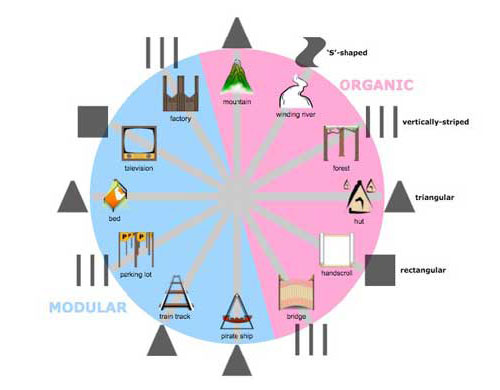
In Figure 1 the dark gray shapes around the perimeter indicate the iconic shapes of the tiles. The images in the colored circle are the tiles themselves. The conceptual division between organic and modular tiles is indicated by the division of the circle into pink and blue halves. The light gray axes indicate finer grained conceptual links, e.g. train tracks and rivers can both be used for transportation and huts and beds can both be used for sleeping.
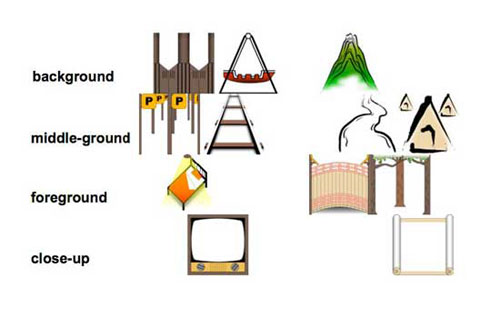
Figure 2 indicates some of the diagrammatic relations between tiles arising from cinematic conventions of vantage point.
3.2 Linking and Shifting in Generative Visual Renku
The relationship between images is determined using an algorithm that computes how well images match each other according to the above annotation system. A linked image will match to a high degree along some combination of the three levels. The author of a generative visual renku work can specify the relative weightings of the imagic, diagrammatic, and conceptual aspects of images in computing a match. Figure 3 below depicts links and shifts between images where the conceptual aspect of the image indicates whether it is a modular (mass-production oriented) object or an organic (natural or handcrafted) object.
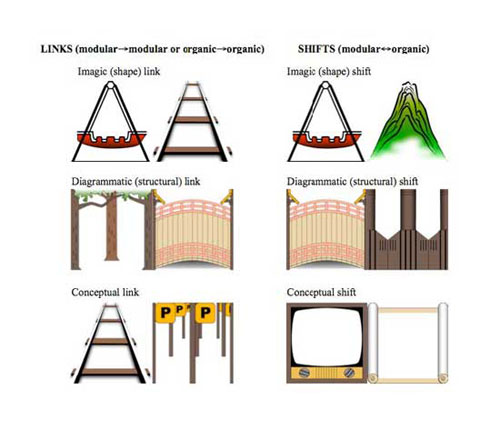
Aside from the linking or shifting between modular or organic objects, the generative visual renku system also uses the matching algorithm to maintain coherence between images. For example, in Figure 3 the imagic (top) row is visually coherent with all of the images sharing a triangular shape. The diagrammatic (middle) row is structurally coherent as each image features closed edges that can be composed with another image's closed edges. Finally, in the conceptual (bottom) row the images share either the conceptual domain of travel (train tracks and parking lot) or entertainment (television and handscroll painting).
We consider the pattern of links and shifts, along with the layout of the images, to comprise a visual discourse structure. The author of a particular work using this framework can easily vary the discourse structure.
3.3 A Brief Technical Overview of the Generative Visual Renku System
The core of this system consists of a server (implemented in LISP) to handle semantics and discourse structuring and a client (implemented in Processing) to handle graphics processing and user input as depicted in Figure 4 below.
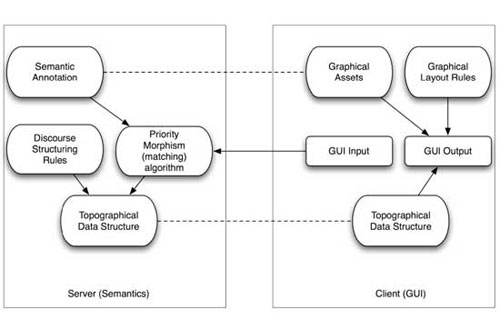
The server consists of the following components: 1) semantic annotation 2) discourse structuring rules 3) priority morphism (matching) algorithm 4) topological data structure
The client consists of the following components: 5) graphical assets (graphical iconic tiles) 6) graphical layout rules 7) duplicate topological data structure 8) GUI input and output protocols
The function and interaction between these components works as follows. Graphical assets are actual image data files. These assets are described on the server side using semantic annotation (the relationship between the metadata annotation and image data files is indicated by a dotted line in Figure 4). This annotation describes the imagic, diagrammatic, and conceptual content of the tiles. For example, the annotation describing the imagic aspect of a "mountain" tile could contain the following (in XML):
<imagic>
<shape>triangle</shape>
<perspective>flat</perspective>
</imagic>
Such metadata describes visual qualities of the image such as its triangular shape. Similar metadata is included for the diagrammatic and conceptual aspects of the image along with weightings for each aspect. For example, conceptual aspects of the mountain tile are represented as follows:
<conceptual>
<conventional>organic</conventional>
<intersubjective>spectacle</intersubjective>
</conceptual>
Without describing all of the details, the XML text indicates that the mountain is considered to be organic according to the author's subjective convention (per our artists' statement) and is considered a spectacle. The XML code is parsed by the system and logical axioms in LISP are produced as in other works authored using the GRIOT system such as discussed in . The matching code (or "priority morphism" code using the terminology of algebraic semiotics) determines matches between image tiles as described above in Section 3.1. The topographical data structure keeps track of the current layout of tiles and is duplicated on the client side (again a tight relationship between server and client elements is indicated by a dotted line in Figure 4) to keep track of where images are displayed in relation to one another. Graphical layout rules utilize the diagrammatic annotation of the tiles to determine how images may or may not be composed. These rules are subjective aesthetic criteria implemented by an author working in the GRIOT framework. They implement a combination of cinematic and graphic design conventions considering shot distance and angle, figure/ground relationships, closed/open edges, and many more attributes.
Currently, user input is accepted solely via clicking on images and output consists of displaying iconic tiles on the screen. Figure 5 is a screenshot of the output of a work of generative visual renku that has been cocreated by a user with a series of selective mouse-clicks and includes human images as a precursor of future work as discussed below in Section 4.
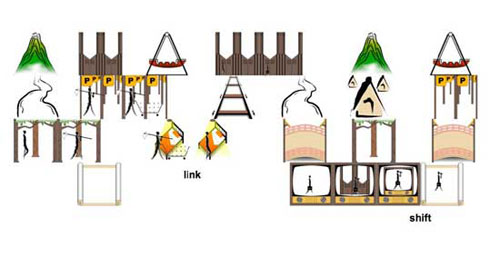
In Figure 5, a user has selected clicked a tile seven times resulting in a left to right progression of successive imagery. The human figure is animated and walks continuously through each tile that the user has clicked.
4 Reflections and Future Directions: Populating Topoi with Transforming Personae
While we are satisfied with the framework of the generative visual renku system in its capacity to create iconic landscapes, we find that these landscapes often reflect the austerity found in some of the generative visual artwork discussed in Section 2.1 above rather than the rich evocative metaphor of written renku poetry. In order to forge a more human connection with the output, and to enrich the capacity of the work to enable reflection on the human condition in our modular and organic landscapes, the next stage of our work will be to further populate the landscape with human figures or personae. The goal will be to expand the system technically as well, blending human personae based on different trajectories of traversing the poetic landscape. For example, in Figure 6 a persona bearing many artifacts such as a camera, backpack, and bicycle becomes a shopping-cart-woman upon entering a parking lot. In this case she has been removed of several artifacts and gains a new one.
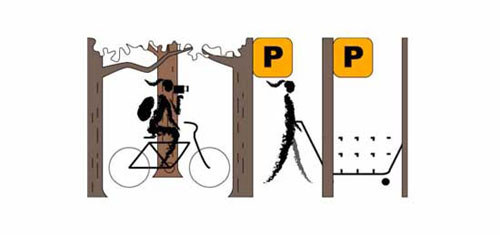
Since we are critically concerned with how our social identities transform based upon our environmental and social contexts and utilization of artifacts, we say that the figure represents a transforming persona. Initially a backpack-camera-bicycle-woman, she transforms into a shopping-cart-woman based upon her new context. This type of transformation is combinatorial, as each of the graphical elements for new artifacts are modular and can be combined with any image of the human. Transformation can occur in other ways, however. A special type of combinatorial relationship is a recursive one. In this type of relationship a graphical element may be nested inside of another one. Unlike the standard combinatorial relationship, a recursive relationship may be duplicated any number of times. Finally, we also can transform characters using procedural techniques such as distorting the image using a visual filter, altering the color, or performing a scaling, shearing, or rotating mathematical transformation. In contrast to the combinatorial and recursive transformations, which treat the image essentially as a whole sign, the procedural transformation treats the image merely as a collection of pixels to be algorithmically altered. Figure 7 below depicts a chart of planned transformation rules for personae inhabiting the poetic landscape of our current generative visual renku system.

In Figure 7, some of the personae are depicted in red. These are special cases where a particular transformation is duplicated via entering the same context twice. Here we intend to implement specially determined rules for more fantastic or striking transformations. For example, the bike-bike-man becomes a sort of cyborg merged with a bicycle, or the boat-boat-man becomes a water-born vessel himself.
Populating our topoi with personae that transform according to rules such as those above represents a rich direction for future work as it would involve new consideration of social, environmental, and artifactual aspects of identity, utilizing the Alloy blending algorithm for blending personae, and algorithmic possibilities for transforming graphical images in addition to composing them as is current done with the tiles.
5 Conclusion
The Generative Visual Renku project aims at extending the possibilities of generative artistic approaches to incorporate emotional meanings and enunciate poignant moments from a formalized system of visual and poetic narrative content. Technically, this required new work including the introduction of a robust GUI client, formal annotation of semantic content of visual images, and new matching (priority morphism) code. Hiraga's framework discussed above assists in this formalization in which syntagmatic structure (quantity, sequence, etc.) is described algebraically in parallel with paradigmatic structure (conceptual similarity or difference). Hence, we can construct mappings from semantic annotations to visual imagery while choosing to preserve varying degrees of the qualities of any given image. Renku has proven a good candidate to serve as a launching point for our research inquiry. The sequentially connected structure of linked verses is particularly promising for making interactive generative works. Its specific structure, rules, multitude of materials and topics, collaborative nature, and expressive precedents, make it a problem that parallels issues arising in computational discourse (e.g. narrative or poetry) generation. Finally, it presents parallel models of authorship, at one level the polymorphic poem designer makes thoughtful and meticulous decisions in constructing and formalizing content, while at another the user and the authored system co-create particular instances of linked visual poetry. Such a format is reflective of this work as a new form with implications for both the arts and technical research. Further, in the future populating the poetic landscapes created with our first stabs creating visual poetry should also enable us with a rich template for engaging our creative and critical concern for the impact our purchases, vehicles, entertainments, and environments have on our daily lives.
References
- W. J. Higginson, "Renku Home," renku.home.att.net/ (accessed December 15, 2007), 2006
- W. J. Higginson, The Haiku Seasons: Poetry of the Nature World. Tokyo, Japan: Kodansha International, 1996.
- D. F. Harrell, "Theory and Technology for Computational Narrative: An Approach to Generative and Interactive Narrative with Bases in Algebraic Semiotics and Cognitive Linguistics," in Computer Science and Engineering. vol. Ph.D. La Jolla: University of California, San Diego, 2007.
- P. Galanter, "Generative Art and Rules-Based Art," Vague Terrain, vol. 03, 2006.
- A. Robbe-Grillet, B. Morrissette, D. Kirkpatrick, K. Racevskiks, and D. Leach, "Generative Literature and Generative Art: New Essays," Fredericton, N.B., Canada: York Press, 1983.
- H. Mathews and A. Brotchie, "Oulipo Compendium," Los Angeles, CA: Make Now Press, 1998.
- P. Galanter, "Generative Art and Rules-Based Art," Vague Terrain, vol. 03, 2006.
- A. Robbe-Grillet, B. Morrissette, D. Kirkpatrick, K. Racevskiks, and D. Leach, "Generative Literature and Generative Art: New Essays," Fredericton, N.B., Canada: York Press, 1983.
- C. Reynolds, "Boids (Flocks, Herds, and Schools: a Distributed Behavior Model)," «http://www.red3d.com/cwr/boids/», (accessed August 30, 2008), 2001.
- I. Calvino, "How I Wrote One of My Novels," in Oulipo laboratory : texts from the Bibliotheque oulipienne, R. Queneau, F. Le Lionnais, and Oulipo (Association), Eds. London: @las, 1995.
- R. Queneau, Cent mille milliards de poémes. Paris, France: Gallimard, 1961.
- C. Xueqin, The Dream of the Red Chamber. New York: Penguin Group, 1996.
- W. J. Higginson, "Renku Home," renku.home.att.net/ (accessed December 15, 2007), 2006
- W. J. Higginson, The Haiku Seasons: Poetry of the Nature World. Tokyo, Japan: Kodansha International, 1996.
- M. K. Hiraga, Metaphor and Iconicity: A Cognitive Approach to Analysing Texts. New York: Palgrave Macmillan, 2005.
- G. Lakoff and M. Johnson, Metaphors We Live By. Chicago, IL: University of Chicago Press, 1980.
- G. Lakoff and M. Turner, More than cool reason -- a field guide to poetic metaphor. Chicago, IL: University of Chicago Press, 1989. http://dx.doi.org/10.7208/chicago/9780226470986.001.0001
- G. Fauconnier and M. Turner, The Way We Think: Conceptual Blending and the Mind's Hidden Complexities. New York: Basic Books, 2002.
- J. Goguen, "An Introduction to Algebraic Semiotics, with Applications to User Interface Design," in Computation for Metaphors, Analogy, and Agents, Yakamatsu, Japan, 1998.
- D. F. Harrell, "Theory and Technology for Computational Narrative: An Approach to Generative and Interactive Narrative with Bases in Algebraic Semiotics and Cognitive Linguistics," in Computer Science and Engineering. vol. Ph.D. La Jolla: University of California, San Diego, 2007.
- P. Harrigan and N. Wardrip-Fruin, "Second Person: Role-Playing and Story in Games and Playable Media," Cambridge, MA: MIT Press, 2007.
- D. F. Harrell, "Algebra of Identity: Skin of Wind, Skin of Streams, Skin of Shadows, Skin of Vapor," in Critical Digital Studies, A. Kroker and M. Kroker, Eds. Toronto: University of Toronto Press, 2008.
- D. F. Harrell, "Walking Blues Changes Undersea: Imaginative Narrative in Interactive Poetry Generation with the GRIOT System," in AAAI 2006 Workshop in Computational Aesthetics: Artificial Intelligence Approaches to Happiness and Beauty, Boston, MA, 2006.
- D. F. Harrell, "Theory and Technology for Computational Narrative: An Approach to Generative and Interactive Narrative with Bases in Algebraic Semiotics and Cognitive Linguistics," in Computer Science and Engineering. vol. Ph.D. La Jolla: University of California, San Diego, 2007.
- J. Goguen, "An Introduction to Algebraic Semiotics, with Applications to User Interface Design," in Computation for Metaphors, Analogy, and Agents, Yakamatsu, Japan, 1998.
- D. F. Harrell, "Shades of Computational Evocation and Meaning: The GRIOT System and Improvisational Poetry Generation," in 6th Digital Arts and Culture Conference, Copenhagen, Denmark, 2005, pp. 133-143.
Appendix: An Example of Interactive Generative Visual Renku
The following progression of images reveals a successive series results from user interactions with the system that gave rise to Figure 5 in the text above. Note the left to right movement of the animated human figure in the visual poem. The current focus of user attention is presented clearly, while other areas are often blurred.
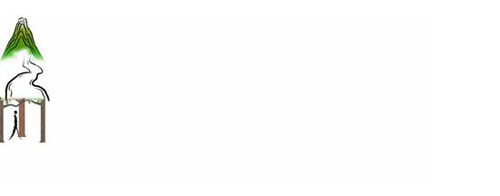
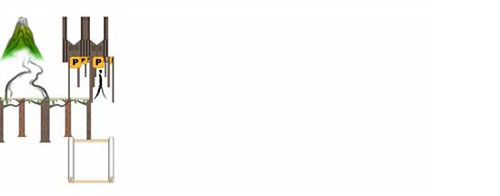
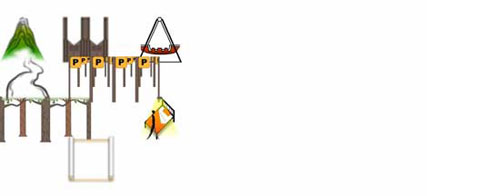
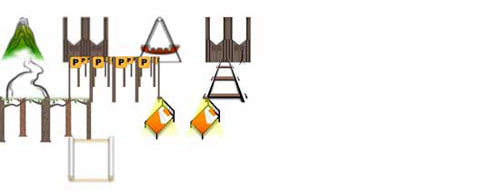
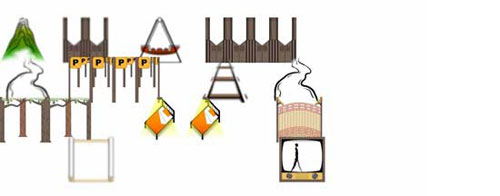

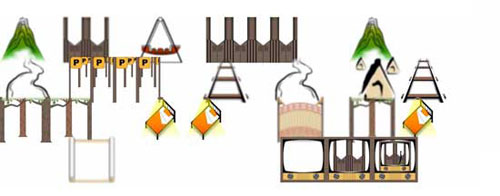
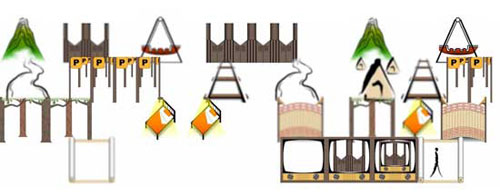
Figure 8: A Succession of eight visual renku screenshots resulting from user input